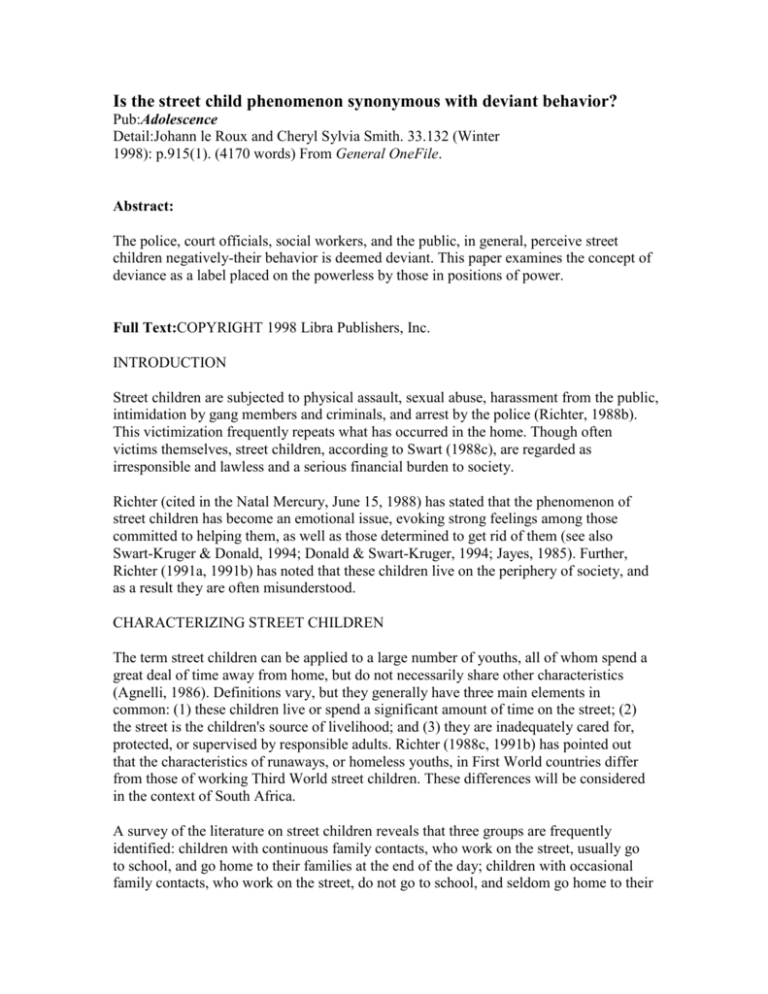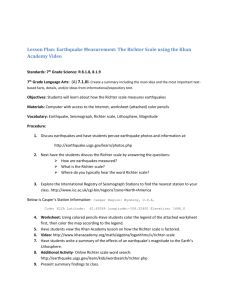Is the street child phenomenon synonymous with deviant
advertisement

Is the street child phenomenon synonymous with deviant behavior? Pub:Adolescence Detail:Johann le Roux and Cheryl Sylvia Smith. 33.132 (Winter 1998): p.915(1). (4170 words) From General OneFile. Abstract: The police, court officials, social workers, and the public, in general, perceive street children negatively-their behavior is deemed deviant. This paper examines the concept of deviance as a label placed on the powerless by those in positions of power. Full Text:COPYRIGHT 1998 Libra Publishers, Inc. INTRODUCTION Street children are subjected to physical assault, sexual abuse, harassment from the public, intimidation by gang members and criminals, and arrest by the police (Richter, 1988b). This victimization frequently repeats what has occurred in the home. Though often victims themselves, street children, according to Swart (1988c), are regarded as irresponsible and lawless and a serious financial burden to society. Richter (cited in the Natal Mercury, June 15, 1988) has stated that the phenomenon of street children has become an emotional issue, evoking strong feelings among those committed to helping them, as well as those determined to get rid of them (see also Swart-Kruger & Donald, 1994; Donald & Swart-Kruger, 1994; Jayes, 1985). Further, Richter (1991a, 1991b) has noted that these children live on the periphery of society, and as a result they are often misunderstood. CHARACTERIZING STREET CHILDREN The term street children can be applied to a large number of youths, all of whom spend a great deal of time away from home, but do not necessarily share other characteristics (Agnelli, 1986). Definitions vary, but they generally have three main elements in common: (1) these children live or spend a significant amount of time on the street; (2) the street is the children's source of livelihood; and (3) they are inadequately cared for, protected, or supervised by responsible adults. Richter (1988c, 1991b) has pointed out that the characteristics of runaways, or homeless youths, in First World countries differ from those of working Third World street children. These differences will be considered in the context of South Africa. A survey of the literature on street children reveals that three groups are frequently identified: children with continuous family contacts, who work on the street, usually go to school, and go home to their families at the end of the day; children with occasional family contacts, who work on the street, do not go to school, and seldom go home to their families; and children without family contacts, who consider the street their home, and it is there that they seek shelter, food, and a sense of belonging among peers. Lusk (1992) has emphasized the psychological characteristics of four groups of street children: poor, working children who return to their families at night and usually attend school - they are not likely to exhibit delinquent behavior; independent street workers, whose family ties are in the process of breaking down - their school attendance is erratic and they exhibit increasing delinquency; children who live and work with their families on the street poverty is the overwhelming reason for their presence; and children who have broken off all contact with their families - they live full time on the streets and are the "real" street children. Aptekar (1994) divides the process into stages, beginning with the child spending a small amount of time away from home, and progressing to the total adoption of the street lifestyle and culture (compare Baizerman, 1988; Visano, 1990). Richter (1988a), Konanc (1989), Cosgrove (1990), and Aptekar (1995a) have stated that street children can be defined according to their relationships with family. Children of the street have left home permanently and usually have little or no contact with their families. Children on the street, who constitute the largest group, return home from time to time, usually contributing to the financial support of their families (Ennew, cited in Richter, 1988c; compare Aptekar, 1994). Thus, street children encompass various categories. In addition, this term is commonly used in Africa, while in Europe, the Americas, and Australia, the terms homeless children, runaways, throwaways, and pushouts are more common. The United Nations has developed its own definition of street children: "any girl or boy . . . for whom the street in the widest sense of the word, including unoccupied dwellings, wasteland, and so on, has become his or her habitual abode and/or source of livelihood, and who is inadequately protected, supervised, or directed by responsible adults" (Inter-NGO, cited in Swart-Kruger & Donald, 1994, p. 108). Cockburn (1991), noting that most differences in definitions are largely semantic, has defined street children as "those who have abandoned their homes, schools and immediate communities, before they are sixteen years of age, and have drifted into a nomadic street life" (p. 12). Richter (1988a) would add, "or those who have been abandoned by their families." Keen (1989) has proposed the following definition: "A street child is regarded as one who has run away from home and is living on the streets apart from any adult supervision or care" (p. 11). Cosgrove (1990) has emphasized the degree of family involvement and the amount of deviant behavior: a street child is "any individual under the age of eighteen whose behavior is predominantly at variance with community norms, and whose primary support for his/her developmental needs is not a family or family substitute" (p. 192). A recent report by the Human Sciences Research Council (HSRC) of South Africa (cited in Schurink & Mathye, 1993) has put forward the following definition: "A street child is any girl or boy who is under the age of eighteen and who has left his/her home environment part time or permanently (because of problems at home and/or in school, or to try to alleviate those problems) and who spends most of his/her time unsupervised on the street as part of a subculture of children who live an unprotected communal life and who depend on themselves and each other, and not on an adult, for the provision of physical and emotional needs, such as food, clothing, nurturance, direction and socialization" (p. 5). According to Aptekar (1995a), it has been a common practice to refer to street children as a more or less unified group. However, the uniqueness of each street child should be acknowledged: "The term street children and youth embraces a diverse group of young people dislocated, to various degrees, from family, school and community, who tend to congregate in inner-city areas. Their reasons for being on the street vary, as do their probable educational and adjustment outcomes" (Richter & Swart-Kruger, 1995, p. 31). It has also been suggested that children who have adjusted to street life are not easily convinced that there is a better alternative (Agnelli, 1986). Samper, cited in Aptekar (1995a), has gone so far as to refer to these children as a "plague." Aptekar (1995a) has argued that, in most cases, street children are lumped together with working children who return to their families at the end of the day to live a normal but impoverished family life. This serves to make the problem of homelessness seem much greater than it actually is. In fact, the great majority-well over three-quarters and as many as ninety percent in various developing countries - live at home but work on the streets to earn money for their families (Aptekar, 1994). Geddes (1993), however, has stated that although few street children are actually homeless or orphans, they are functionally homeless. Their parents are incapable of caring for them due to such problems as substance abuse and poverty (similar findings have been reported by Ennew, 1986, 1994; Lusk, 1992; Myers, 1989; Ojanuga, 1990; Patel, 1990; UNICEF, 1986). A useful typology developed by UNICEF (cited in Aptekar, 1994) has classified street children in relation to their development. It reflects the belief that the experience of children who work on the street is considerably different from children who must look to a peer group or gang for the fulfillment of primary needs, such as protection, sustenance, and nurture. Aptekar (1994) has noted that some researchers classify street children by the different types of experiences they have, including the quality of their play and work and their relations with peers and authority figures. In addition, age and gender are important factors. There is also the popular misconception that equates street children with gangs (compare Scharf et al., 1986; Swart, 1988a). Unfortunately both the police and the public are predisposed to characterize street children in this way. Visano (1990) has claimed that street children are defined mainly by two dimensions: the amount of time spent on the streets and the absence of contact with responsible adults. However, this ignores the individual differences among them, such as coping style. DEVIANCE Highly charged reactions to street children make it difficult to remain objective. Thus, the children's ability to survive under the most trying circumstances may be understated, or their problems minimized, making them appear as modern-day Huckleberry Finns. According to Aptekar et al. (1995), "it is so difficult to know to what degree the children are honest, to what degree one's perception of them is accurate, and how what is written about them will be perceived by readers" (pp. 2-3). Adults' negative interpretations of the lifestyle and hostile, condemnatory responses to street children would seem to make it almost impossible for them to retain healthy selfesteem (Richer, 1989a; compare Scharf et al., 1986; Swart, 1988b). Wilson and Arnold (1986) have stated that "their silent scream and inner rage surface as they cut loose and take to the streets. There are few safety nets for them, because they are alienated from our society and because we regard them as 'deviants' and 'social junk'" (p. 7). Further, "they feel exploited by almost everyone: the media, the pushers, the sex purchasers, the sociologists, and the do-gooders" (p. 6). South African street children are generally thought of as sly, manipulative, deceitful troublemakers. According to Richter (1991b), "like all stereotypes, these cameos contain a little bit of truth, often enough to reinforce and maintain the stereotype" (p. 6). In addition, these negative appraisals are predominantly all-embracing, and no concessions are made that bad behavior may be temporary or situational (Richter, 1989b). According to Goliath (1989), "street children are a burden on society. These children often become the adult layabouts and criminals of the future" (p. 5). The literature, on the whole, reveals that by society's standards, street children deviate from social, moral, and legal norms. Swart (1988c) has stated that although some people condone the behavior of street children as that which is to be expected under the circumstances, it is generally "considered deviant in terms of childhood and community norms" (p. 8). Further, SwartKruger and Donald (1994) have stated that "it is not surprising . . . that lying and deceit are fundamental tools of survival in an adult world which has aligned itself against them" (p. 120). Hansson (1991), citing Posel (1990), has claimed that since 1976, when many black children left their homes to take up the political struggle against apartheid, the media have depicted them as being symbols of"anarchy, barbarism, criminality and spiraling violence" (p. 8). According to Hansson, this explains why most programs have been aimed at reinstating adult control and resocializing such children by getting them off the streets and back into some form of schooling. Similarly, Richter (1988c) has pointed out that "one of the chief difficulties in trying to help street children is to find ways of bringing them back into so-called normal society. . . . Their socialization into this lifestyle has been prematurely and, often, traumatically ended" (p. 3). Richter (1988a) has noted that the longer the children spend on the streets, the more likely it is that they will enter into criminal activities. It would appear that street children engage in criminal activities mainly to ensure their own survival. According to Agnelli (1986), "street children as such are not delinquent, but only immediate candidates for delinquency if their needs are not met" (p. 112). Society's negative opinion of these children, the low expectations of them, and the closing of legitimate avenues' of opportunity may push them into delinquency, resulting in a self-fulfilling prophecy. According to Swart (1988a), a few street children, feeling humiliated and frustrated, have even threatened adults with violence for making their lives unbearable. Paton (1990) has noted that "a child is more often delinquent because he has been deprived of . . . the fundamental needs of security, affection and outlets for his creative and emotional impulses. The change in him is remarkable when these deep needs are satisfied" (p. 99). In general, street children are perceived by the public as being "deviant" (Swart, 1988b; Mangwana, 1992; Konanc, 1989). Haralambos and Holborn (1992) define deviance as "those activities which bring disapproval from members of society" (pp. 580-581). Richter's (1988a) findings indicate that about one fifth of street children may be involved in antisocial activities, with some having acquired a set of attitudes and beliefs congruent with criminality. Further, "the high visibility of criminal or delinquent activities, even among a small group of street children, tends to antagonize the communities in which they occur, and they provide the authorities with a rationale for adopting a punitive attitude towards all street children" (Richter, 1988a, p. 13). Agnelli (1986) has stated that the outcome of having to adjust, often alone, in a hostile environment is involvement in delinquent activities. Cemane (1990) has taken a more categorical stance: "street children have no incentive to conform to social sanctions that inhibit antisocial behavior, and will seize any opportunity to engage in deviant behavior" (p. 2). The brutality of street life and negative interactions with authorities may set into motion a process of primary and secondary deviance, with terrible consequences. Involvement in petty crime, or even proximity to such crime, has frequently made street children victims of violence. Dewces and Klees (1995), citing research from Childhope, have stated that, between 1988 and 1990, an estimated 4,611 Brazilian children and adolescents were murdered by renegade police and vigilante groups. It is possible that the labeling of street children as deviant pushes them more deeply into antisocial behavior. They may even come to accept society's perceptions of them. This labeling serves to further isolate them from society, intensifying their victimization (Alexander, 1987; O'Connor, 1989; Olson et al., 1980; Aptekar, 1988). Kennedy (1987) has stated that being labeled homeless carries many connotations: dirty, lazy, alcoholic, delinquent, and drug addicted. Perceptions beget attitudes, which, regarding street children, are negative - they are troublesome, they are undeserving. "So we provide separate services for them in separate hostels or houses, and what services there are, are provided not by the statutory bodies but by underfunded voluntary agencies. This in turn reinforces society's attitudes towards these children, that they don't deserve any better" (Kennedy, 1987, p. 19). Commenting on street children in the Americas, Connolly (1990) has stated that, on the whole, these children are regarded as either delinquent or deviant. The fact that children who have spent a considerable amount of time on the streets frequently run away from both government and private programs is used as evidence to support the common belief that they are uneducable and incorrigible (see also Balanon, 1989; Konanc, 1989; Hickson & Gaydon, 1989). According to Richter (1989b), UNICEF has identified the inhibition of self-confidence and self-esteem, brought about by society's negative perception of street children and their work, as a significant element in their exploitation (compare Keen, 1990; Richter, 1988a). Labeling theory views the determination of deviance as a dynamic process. Who is to be considered deviant comes about in the interplay between the powerless and the powerful (Thio, 1988). That the majority expect street children to be criminals as adults (Swart, 1988d) therefore has important repercussions. Haskell and Yablonsky (1987) have stated that "a youth is defined as a juvenile delinquent when that status is conferred upon him by a court" (p. 7). Thus, when arrested, street children are often incarcerated with adult offenders, who instruct them in the tricks of the trade. This may lead to the entrenchment of a criminal career (Swart, 1988a; compare Olson et al., 1980; Nye, 1980; Gullotta, 1979; Young et al., 1983). CONCLUSIONS Increasing numbers of children live on the streets (Cemane, 1990; Richter, 1991a; Peacock, 1994). Once there, the attitudes and perceptions of society become the catalyst for the mainly negative self-perceptions that street children have of themselves (Konanc, 1989). The support of other street children, however, may act as a significant emotional buffer (Donald & Swart-Kruger, 1994). According to Richter (1991a), "children are most especially harmed on the streets by the harsh physical conditions, by violence and harassment, by labor exploitation, by absorption into criminal networks, and by denial of their right to receive an education that will equip them to achieve a better life" (p. 8). Interventions have ranged from government programs to projects by volunteers. These efforts, until recently, have been minimal, probably due to street children's marginality to society (Cockburn, 1991). Richter, citing Agnelli (1986), has claimed that the presence of street children is an indictment of the way society construes its priorities. These children, who endure significant hardship but hope one day to rejoin the community as productive members, are ignored by a society that systematically excludes them (Richter, 1989a). REFERENCES Agnelli, S. (1986) Street children: A growing urban tragedy. London: Weidenfeld & Nicolson. Alexander, M. (1987). Street children: Towards global awareness and action. A study of resources available to homeless children in Guatemala, C.A. Unpublished honors dissertation, Newcomb College, Tulane University. Aptekar, L. (1988). The street children of Call. Durham, NC: Duke University Press. Aptekar, L. (1994). Street children in the developing world: A review of their condition. Cross-Cultural Research, 28(3), 195-224. Aptekar, L. (1995a). Educating the public about the coping strategies of street children. Paper presented at the Tenth National Congress of the South African Association for Child and Adolescent Psychiatry (Children of Africa: Risk, Resilience, Challenge and Change), Durban. Aptekar, L. (1995b). Street children: A cross-cultural perspective. Paper presented at the HSRC Conference (Street Children: From Resolutions to Action), Pretoria. Aptekar, L., Cathey, P. J., Ciano, L., & Giardino, G. (1995). Street children in Nairobi, Kenya. African Urban Quarterly, 10, 1-26. Baizerman, M. (1988). Street kids: Notes for designing a program for the youth of and on the streets. The Child Care Worker, 6(11), 13-15. Balanon, L. G. (1989). Street children: Strategies for action. Child Welfare, 68(2), 159166. Cemane, K. B. (1990). The street-child phenomenon. Social Work Practice, 1(90), 2-5. Cockburn, A. (1991). Street children: An overview of the extent, causes, characteristics and dynamics of the problem. The Child Care Worker, 9(1), 12-13. Cockburn, A. (1995). Looking after street children: A model indigenous to South Africa. Paper presented at the Tenth Biennial Conference of the National Association of Child Care Workers, Cape Town. Connoly, M. (1990). Adrift in the city: A comparative study of street children in Bogota, Colombia, and Guatemala City. In B. Boxhill (Ed.), Homeless children: The watchers and the waiters (pp. 129-149). New York: Haworth Press. Cosgrove, J. (1990). Towards a working definition of street children. International Social Work, 33, 185-192. Dewees, A., & Klees, S. J. (1995). Social movements and the transformation of national policy: Street and working children in Brazil. Comparative Education Review, 39(1), 76100. Donald, D., & Swart-Kruger, J. (1994). The South African street child: Developmental implications. South African Journal of Psychology, 24(4), 169-174. Ennew, J. (1986). Children of the streets. New Internationalist, 164, 10-11. Ennew, J. (1994). Parentless friends: A cross-cultural examination of networks among street children and street youth. In F. Nesman & K. Hurrelman (Eds.), Social networks and social support in childhood and adolescence. London: De Gruyter. Geddes, F. (1993). The drugging patterns and attitudes towards substance abuse in a group of Johannesburg street children. Unpublished master's thesis, University of the Witwatersrand, Johannesburg. Goliath, D. (1989). The problem that grows and grows. Prisma, 4, 4-5. Gullotta, T. (1979). Leaving home: Family relationships of the runaway child. Social Casework, 60(2), 111-114. Hansson, D. (1991). We the invisible: A feminist analysis of the conception of "street children" in South Africa. Cape Town: Institute of Criminology, University of Cape Town. Haralambos, M., & Holborn, M. (1992). Sociology: Themes and perspectives (3rd ed.). London: Harper Collins. Haskell, M. R., & Yablonsky, L. (1987). Juvenile delinquency. Chicago: Rand McNally College Publishing. Hickson, J., & Gaydon, V. (1989). Counselling in South Africa: The challenge of apartheid. Journal of Multicultural Counselling and Development, 17(2), 85-94. Jayes, C. S. (1985). Some characteristics of a group of coloured runaway boys aged 8-16 years and factors that these boys and their mothers perceived as contributing to their runaway behavior. Unpublished master's thesis, University of Cape Town. Keen, J. (1989). A window on the world: A study into the values, interests, perceptions and aspirations of female street children. Research project, University of Cape Town. Keen, J. (1990). Dealing with street children. The Child Care Worker, 8(11), 8-9. Kennedy, S. (Ed.). (1987). Streetwise: Homelessness among the young in Ireland and abroad. Glendale Press. Konanc, E. (1989). Street children and children working in the street: Preliminary results of a field study in Turkey. The Child Care Worker, 7(11), 13-15. Lusk, M. (1992). Street children of Rio de Janeiro. International Social Work, 35, 293305. Mangwana, T. (1992). Working with street children: Hints for child care workers. The Child Care Worker, 10(5), 14-15. Maphatane, M., & Schurink, W. (1993). Legislation and welfare policy regarding street children. In W. Schurink (Ed.), Street children. Pretoria: HSRC. Myers, W. (1989). Urban working children: A comparison of four surveys from South Africa. International Labor, 128, 321-335. Natal Mercury. (1988, June 15). Durban. Page 3. Nye, F. I. (1980). A theoretical perspective on running away. Journal of Family Issues, 1(2), 14-19. O'Connor, I. (1989). Our homeless children: Their experiences. Report to the National Inquiry into Homeless Children by the Human Rights and Equal Opportunity Commission. Sydney: The Printing Place. Ojanuga, D. (1990). Kaduma beggar children: A study of child abuse and neglect in northern Nigeria. Child Welfare, 69, 371-380. Olson, L., Liebow, E., Mannino, F. V., & Shore, M. F. (1980). Runaway children twelve years later: A follow-up. Journal of Family Issues, 1(2), 176-185. Patel, S. (1990). Street children, hotel boys and children of pavement dwellers and construction workers in Bombay: How they meet their daily needs. Environment and Urbanization, 2, 9-26. Paton, A. (1990). Diepkloof: Reflections on Diepkloof Reformatory. Cape Town: David Philip. Peacock, R. (1994). Street children. Africa Insight, 24(2), 138-143. Richter, L. (1988a). Street children: The nature and scope of the problem in Southern Africa. The Child Care Worker, 6(7), 11-14. Richter, L. (1988b). A psychological study of street children in Johannesburg: An investigation requested by "Street-Wise," Johannesburg (Report 89-01). Pretoria: Unisa. Richter, L. (1988c). Thinking on your feet in the street: Discussion to determine the educational potential of a group of"street children" in Johannesburg. Address delivered at the Open Day of the Unit for Cognitive Development. Pretoria: Vista University. Richter, L. (1989a). South African street children: Comparisons with Anglo-American runaways. Pretoria: Unisa. Richter, L. (1989b). Descriptions of self, family and society given by street children in Johannesburg. Paper presented at the Seventh National Congress of the South African Association for Child and Adolescent Psychiatry and Allied Disciplines, Cape Town. Richter, L. (1991a). Street children in South Africa: General theoretical introductionSociety, family and childhood. The Child Care Worker, 9(8), 7-9. Richter, L. (1991b). Street children in South Africa: Street children in rich and poor countries. The Child Care Worker, 9(9), 5-7. Richter, L., & Swart-Kruger, J. (1995). AIDS risk among street children and youth: Implications for intervention. South African Journal of Psychology, 25(1), 31-38. Scharf, W., Powell, M., & Thomas, E. (1986). Strollers: Street children of Cape Town. In S. Burman & P. Reynolds (Eds.), Growing up in a divided society: The context of childhood in South Africa. Johannesburg: Ravan Press. Schurink, W., & Mathye, M. (1993). Orientation. In W. Schurink (Ed.), Street children. Pretoria: HSRC. Swart, J. (1986). My professional life on the streets. In N.J. Pines (Ed.), Street children: Four perspectives. The Institute for the Study of Man in Africa (ISMA Paper No. 40). Johannesburg: University of the Witwatersrand. Swart, J. (1987). Street children: Refugees, drop-outs or survivors? The Child Care Worker, 5(10), 6-8. Swart, J. (1988a). "Street-wise": Opening the way to self-actualization for the street child. Africa Insight, 18(1), 33-41. Swart, J. (1988b). Community perceptions of street children in Hillbrow. The Child Care Worker, 6(6), 11-13. Swart, J. (1988c). Community and self-perceptions of the black South African street child. Paper presented at the International Workshop on the Ethnography of Childhood, Cambridge University, Cambridge. Swart, J. (1988d). An anthropological study of street children in Hillbrow, Johannesburg, with special reference to their moral values. Master's thesis, University of South Africa, Pretoria. Swart-Kruger, J., & Donald, D. (1994). Children of the South African streets. In A. Dawes & D. Donald (Eds.), Childhood and adversity: Psychological perspectives from South African research. Cape Town: David Philip. Thio, A. (1988). Deviant behavior (3rd ed.). New York: Harper & Row. UNICEF. (1986). Children in especially difficult circumstances: Exploitation of working and street children. New York: United Nations Children Fund. Visano, L. (1990). The socialization of street children: The development and transformation of identities. Sociological Studies of Child Development, 3, 139-161. Wilson, P., & Arnold, J. (1986). Street kids: Australia's alienated young. Victoria: Collins Dove. Young, R. L., Godfrey, W., & Adams, G. R. (1983). Runaways: A review of negative consequences. Family Relations, 32, 16-24. Source Citation Roux, Johann le, and Cheryl Sylvia Smith. "Is the street child phenomenon synonymous with deviant behavior?" Adolescence 33.132 (1998): 915. General OneFile. Web. 17 Nov. 2009. <http://find.galegroup.com/gps/start.do?prodId=IPS&userGroupName=camb70211>. Gale Document Number:A53870306





